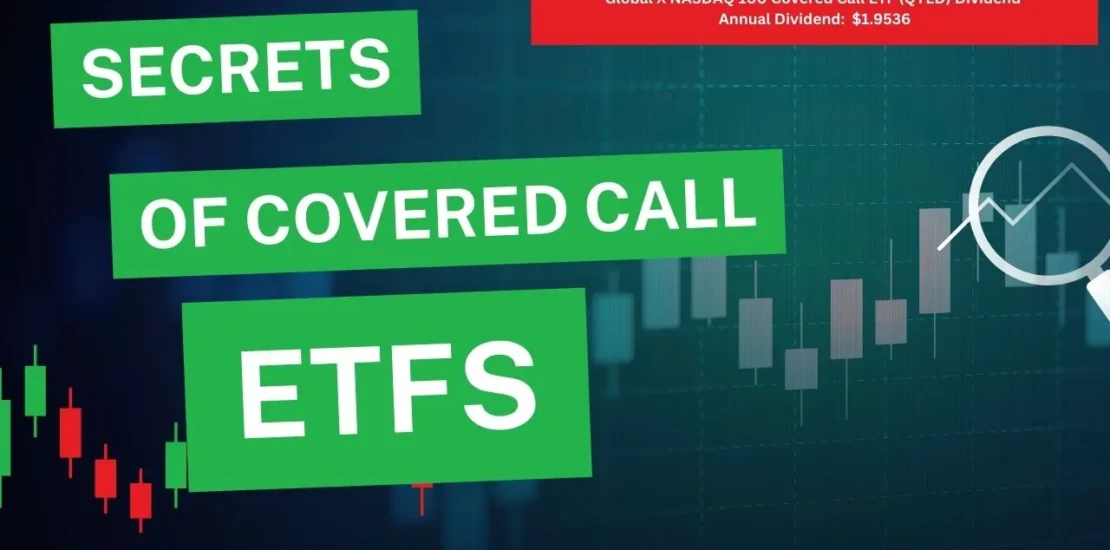- May 27, 2024
- Posted by: Mark S
- Categories: Options Trading, Stock Trading, Swing Trading, Trading Article

Would you like 100% passive income, with low minimums and high liquidity when you need it?
I want to tell you about a little-known investment strategy that could seriously boost your portfolio’s earning potential: covered call ETFs. These innovative funds combine the stability of blue-chip stocks with the income-generating power of options trading. And the best part? You don’t need to be a Wall Street wizard to take advantage of them.
Imagine a strategy where you invest once and then sit back to enjoy a steady stream of income month after month.
These innovative investment vehicles allow you to benefit from the lucrative options market without the constant hassle and complexity of trading covered calls on individual stocks. Otherwise known as work :)
What is an ETF?
Exchange-traded funds (ETFs) are investment vehicles that pool money from many investors to buy a basket of securities, such as stocks or bonds. They offer the diversification of mutual funds but trade like stocks on exchanges, providing liquidity and flexibility.
Now, imagine combining the income-generating potential of options trading with the ease and accessibility of ETFs.
That’s precisely what covered call ETFs offer.
These innovative funds hold a portfolio of stocks and sell call options on those stocks, generating income from the option premiums. In essence, they do the heavy lifting of a covered call strategy, allowing investors like you to sit back and potentially earn regular income – passively.
Join us LIVE – Wednesday June 5th @ 12pm Eastern/9am Pacific/4pm GMT. Invest Once – Earn Forever
What is a Covered Call?
A covered call involves owning a stock and selling a call option against it. This strategy allows you to earn a premium from the option sale, providing additional income. If the stock’s price stays below the option’s strike price, you keep the premium and the stock. If the stock’s price exceeds the strike price, you may have to sell your stock at the agreed price, which could limit your gains.
While many of you have heard about covered calls on stocks, and there are some real advantages, it always comes with regular work and time.
Let’s take a look at the pros vs cons:
Trading Covered Calls on Individual Stocks
Pros:
- Higher Potential Returns: Since you select the stocks and call options, you can tailor the strategy to target higher returns.
- Control: You can choose specific stocks you believe in and manage your strategy closely.
- Flexibility: You can select various option strategies such as in-the-money (ITM), at-the-money (ATM), or out-of-the-money (OTM) options to suit your market outlook and risk tolerance.
Cons:
- Time-Consuming: Managing a covered call strategy requires constant monitoring and monthly adjustments. This can be a lot of work for busy investors.
- Complexity: Understanding options and making the right choices can be challenging. It’s not easy.
- Transaction Costs: Frequent trading can incur higher transaction costs, reducing overall returns.
- High Minimums: You must buy at least 100 shares of any stock you want to write covered calls. Given the valuations of many stocks, this can require $10K – $100K for just 100 shares of stocks.
Despite the cons, what if we could enjoy all the “pros” and find a better way?
The challenge is how do we make this truly “passive”? And not another job. To the rescue are Covered Call ETFs.
Let’s take a look:
Investing in Covered Call ETFs
Covered Call ETFs simplify this process by bundling stocks and managing the covered call strategy for you.
Pros:
- Ease of Use: Once you invest in a Covered Call ETF, you don’t have to manage the options strategy yourself. The fund does it all for you. Invest once, potentially earn forever.
- Regular Income: Many Covered Call ETFs distribute monthly income, making them attractive for investors seeking consistent cash flow.
- Diversification: These ETFs often hold a diversified portfolio of stocks, reducing the risk of holding individual stocks.
- Low Minimum: Trade at virtually any online broker, AND you can start for $100 if you like.
Cons:
- Lower Potential Returns: The returns might be lower than a well-executed individual stock strategy because the ETF is designed to maximize income/dividends and not stock upside.
- Management Fees: ETFs charge management fees, which can eat into your returns over time.
Examples of Covered Call ETFs
1. QYLD – Global X NASDAQ 100 Covered Call ETF – QYLD is one of the most popular covered call ETFs, with over $8 billion in assets under management as of May 2024. It tracks the CBOE NASDAQ-100 BuyWrite V2 Index, which holds a portfolio of NASDAQ-100 stocks, and writes monthly at-the-money call options on the index.
One key metric to consider when evaluating covered call ETFs is the 12-month trailing yield, which indicates the income generated by the fund over the past year. QYLD boasts an impressive 12.35% trailing yield, making it an attractive option for income-seeking investors.
However, it’s important to note that the fund charges an expense ratio of 0.60%, which is the annual fee charged by the fund managers.
2. XYLD – Global X S&P 500 Covered Call ETF – XYLD is another covered call ETF from Global X, focusing on the S&P 500 index. It follows a similar strategy to QYLD, writing monthly at-the-money call options on the index. XYLD has $3 billion in assets under management, a 12-month trailing yield of 9.95%, and an expense ratio of 0.60%
3. RYLD – Global X Russell 2000 Covered Call ETF – RYLD provides exposure to small-cap U.S. stocks through the Russell 2000 index, while employing a covered call strategy. It writes monthly at-the-money call options on the index, generating income for investors. RYLD has $1.4 billion in assets, a 12-month trailing yield of 13.17%, and an expense ratio of 0.60%.
Sneak Preview: There are even Covered Call ETFs now on popular, individual stocks. However, these deserve their trading article because there are some clear-cut disadvantages that you have to be aware of. Watch for a future article.
Benefits of Covered Call ETFs
One of the main advantages of covered call ETFs is that they offer a simplified way to implement a covered call strategy. Instead of managing individual stock positions and options contracts, you can access this strategy through a single investment.
Covered call ETFs also provide a measure of downside protection. The income generated from selling call options can help offset potential losses if the underlying stocks decline in value.
Market Volatility and Covered Call ETFs
Covered call ETFs can be particularly attractive during periods of high market volatility. When volatility increases, the premiums received from writing call options tend to rise, potentially leading to higher income for the fund and its shareholders.
Liquidity and Ease of Trading
One of the advantages of covered call ETFs is their liquidity and ease of trading. Like other ETFs, covered call ETFs can be bought and sold throughout the trading day on stock exchanges, providing investors with flexibility and the ability to quickly adjust their positions.
Different Covered Call Strategies: Tailoring Your Approach
Covered call ETFs use various strategies to generate income and manage risk. These strategies involve selling call options with different strike prices and expiration dates, each with its own set of advantages and trade-offs.
Let’s look at some of the most common covered call strategies and how they might fit into your investment approach.
1. In-the-Money (ITM) Calls
In-the-money call options have a strike price lower than the current price of the underlying stock or index. When a covered call ETF sells ITM calls, it provides a higher level of downside protection, as the option premium received is higher. However, this strategy also limits the fund’s upside potential, as the shares are more likely to be called away if the stock price rises above the strike price.
2. At-the-Money (ATM) Calls
At-the-money call options have a strike price that is close to the current price of the underlying stock or index. Selling ATM calls strikes a balance between generating income and allowing for some upside potential. The option premiums received are typically lower than those of ITM calls but higher than those of out-of-the-money calls.
3. Out-of-the-Money (OTM) Calls
Out-of-the-money call options have a strike price higher than the current price of the underlying stock or index. When a covered call ETF sells OTM calls, it allows for more upside potential, as the stock price has more room to grow before reaching the strike price. However, the option premiums received are lower compared to ITM or ATM calls, resulting in less income generation.
4. Zero Days to Expiry (0DTE) Calls
Zero days to expiry call options are very short-term options that expire within a day or less. These options are highly speculative and can be extremely volatile, as they are sensitive to even small price movements in the underlying stock or index. Selling 0DTE calls can generate significant income due to the high premiums associated with these options, but it also comes with substantial risks.
Choosing the Right Covered Call Strategy
The covered call strategy that’s right for you will depend on your investment objectives, risk tolerance, and market outlook. Some covered call ETFs focus on a single strategy, while others may use a mix of approaches for different market conditions.
When evaluating covered call ETFs, look beyond the headline yield and expense ratio and understand the underlying strategy being used. By lining up the ETF’s approach with your own investment goals and risk profile, you can make better decisions and potentially optimize your income generation while managing risk.
Depending upon the strategy chosen, this will significantly impact your regular cash flow and potential upside for your underlying investment. This is key to understanding the performance and future potential.
Conclusion
Covered Call ETFs offer a compelling solution for investors seeking hassle-free, consistent income. Unlike trading covered calls on individual stocks, which require time, effort, and expertise, Covered Call ETFs let you invest once and earn forever.
With professional management, diversification, and various strategies, these ETFs provide a practical and efficient way to capitalize on the options market.
If you’re looking for a way to generate regular income without the constant grind, Covered Call ETFs might be your perfect investment companion.
If you’d like to learn how we choose from the best passive income opportunities, including our choice of the top index and individual stock-covered call ETFs along with using market timing to maximize our returns and safety – be sure to join us at our upcoming live online workshop:

